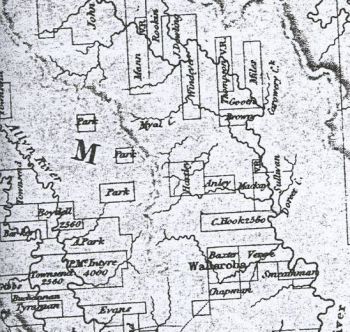Duncan Forbes Mackay - Settler
Melbee - Map 3
In January 1838 Duncan Forbes Mackay was granted 2560 acres of land near Dungog, an original grant to Grayson Hartley however he was in the district much earlier than this.

Arrival in the Colony
Duncan Forbes Mackay arrived on the Orpheus in 1826Newcastle
He was appointed Superintendent of Public Works at Newcastle in 1826, taking over from Frederick Dickson. Later that year he became embroiled in a dispute with Captain Robert Robinson of the veterans who was stationed in Newcastle and resented Mackay's superior accommodation. This dispute eventually resulted in the Court-martial of Captain Robert Robinson for libel against Governor Darling. [3]Duncan F. Mackay was responsible for many improvements in the township including converting a former blacksmith's shop to Barracks for the convicts.
Dungog
Possibly as early as the 1830's a stone homestead was constructed on his land at Dungog, which fronted the Williams River and in 1831 he was purchasing seed wheat from Mr. Burnett of the Australian Agricultural Company.By 1833 he had been appointed Clerk to the Bench of Magistrates and was active on the Committee of the Stock Protection Association.
Assigned Convict Servants
Some of the convicts who were assigned to Mackay at Dungog were :Michael Casey, arrived on the Brampton in 1823
Patrick Wood, arrived on the John Barry in 1821
Thomas Ivory a 67 year old who arrived on the Ferguson in 1829
16 year old farm boy James Lawler who died in Newcastle Hospital in 1849
Henry Ellis, age 17, arrived on the John Barry in 1836
William Spetch a young boy, arrived on the Hercules in 1832
Duncan F. Mackay was one of about 15 Hunter Valley settlers to receive young lads who arrived on the ships Planter and Hercules in 1832. The boys, mostly under 16 years of age, were to stay with the master they were assigned to for the duration of their 7 year sentence and not to be transferred or re-assigned in any way. The settlers were instructed by the authorities to make endeavours to instruct and care for their charges until they should reach manhood.
Illness and Death
In November 1846 he was admitted to Darlinghurst gaol from Dungog for examination. He was sent from there to the 'lunatic' asylum at Tarban Creek. He was admitted again to the same place in 1852 [1]Duncan Forbes Mackay died at Sion House, Cumberland Street, Sydney on 1st February 1860 aged 67. [2]
Land Acquisition
The Mackay family also acquired estates at Whittingham Dulcamah, (Minimbah) and Maitland (Anambah) and Cangon at Dungog.New South Wales Heritage site recorded the following information about the Mackay family....
Duncan Forbes Mackay did not marry and had no children but, in the 1830s, he encouraged his brother John to join him at his property 'Melbee'. John, his wife Sybella and seven children, came to Melbee about 1839.
Duncan Forbes Mackay Jnr (nephew to Duncan Forbes Mackay Snr) was the sixth child and forth son of John and Sybella Mackay. Two more children arrived to them in 1840 and 1841.
By 1850, Duncan Forbes Mackay Snr made over his estate to his brother's family. John's nine children were eligible marriage partners for several of the offspring of the Hunter Valley's aristocracy including the neighbouring Hooke and Dowling families and the Sparke and Cobb families of the Maitland area'.
Notes and Links
1). An article in the Dungog Chronicle dated 1 June 1945 mentions the Mackay family...Melbee was granted to Duncan Forbes Mackay, a bachelor who had come from Prince Edward's Island, America. The Mackay Clan seem to have been ultra Covenanters and followers of the Bonny Prince Charles, for when the Stuarts failed to regain the English Crown many of them left the land of their birth, some to America and others to the continent of Europe. When D.F. Mackay's brother John died in Prince Edward's Island, he sent for the widow and family to come to Melbee. The family comprised George (Melbee), John (Cangon), D. F. (Minimbah), and Charles who lived on the Barwon till he lost his sight and then lived at East Maitland and is the grandfather of Ken and Bob (late of the A.I.F.). The head of the Mackay Clan was Lord Reay, whose family died out and the title was available to George who had inherited Melbee. He was a very religious man and when asked to put in his claim said 'There is only one Lord and I am not He'. In default of his claim , the title went to a branch in Holland. Another incident I remember of George Mackay is that when he was dying his greatest trouble was that he had ONCE lost his temper and used bad language. The daughters of the family were Mrs. Vincent Dowling, Canningalla; Mrs Edward Sparke, East Maitland; Mrs George Cobb, Aberglasslyn; and Mrs. Augustus Hooke Tia Tia, Walcha.
References
[1]. Ancestry.com. New South Wales, Australia, Gaol Description and Entrance Books, 1818-1930 [database on-line]. Provo, UT, USA: Ancestry.com[2]. Empire, 13 February 1860
[3]. The Australian 19 September 1828
↑
